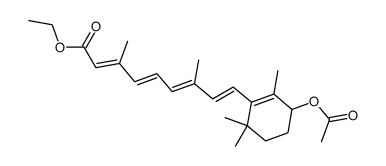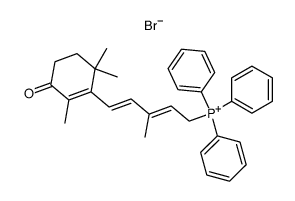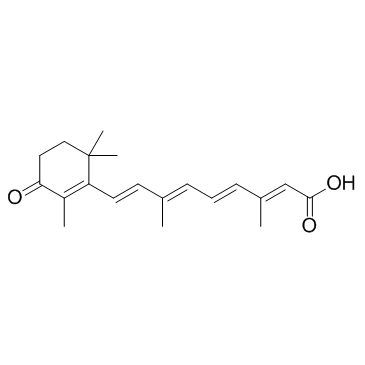66592-72-1
| Name | all-trans-4-hydroxyretinoic acid |
|---|---|
| Synonyms | rac all-trans 4-Hydroxy Retinoic Acid |
| Description | 4-Hydroxyretinoic acid (4-HRA) is a naturally occurring retinoid derivative with diverse biological effects. 4-Hydroxyretinoic acid is formed from retinol catalyzed by cytochrome P-450 isozyme(s), and is mainly metabolized by the liver in the body. 4-Hydroxyretinoic acid also serves as the substrate for human liver microsomal UDP-glucuronosyltransferase(s) and recombinant UGT2B7. 4-Hydroxyretinoic acid regulates gene expression and cell differentiation via binding to nuclear receptor RAR (Retinoic Acid Receptor), and activates RARs and RXR-alpha, to induce cancer cell apoptosis. In addition, 4-Hydroxyretinoic acid is also involved in various physiological processes such as immune regulation, neuroprotection, and anti-oxidation[1][2]. |
|---|---|
| Related Catalog | |
| Target |
UDP-glucuronosyltransferase, cytochrome P-450 isozyme[1]; RAR, RXR-alpha[2] |
| References |
| Density | 1.075g/cm3 |
|---|---|
| Boiling Point | 506.5ºC at 760 mmHg |
| Molecular Formula | C20H28O3 |
| Molecular Weight | 316.43 |
| Flash Point | 274.2ºC |
| Exact Mass | 316.20400 |
| PSA | 57.53000 |
| LogP | 4.57340 |
| Index of Refraction | 1.574 |
|
~% 
66592-72-1 |
| Literature: Rosenberger Journal of Organic Chemistry, 1982 , vol. 47, # 9 p. 1698 - 1701 |
|
~% 
66592-72-1 |
| Literature: Aig, Edward; Focella, Antonino; Parrish, David R.; Rosenberger, Michael; Scott, John W.; Zenchoff, Gladys B. Synthetic Communications, 1987 , vol. 17, # 4 p. 419 - 430 |
|
~% 
66592-72-1 |
| Literature: Aig, Edward; Focella, Antonino; Parrish, David R.; Rosenberger, Michael; Scott, John W.; Zenchoff, Gladys B. Synthetic Communications, 1987 , vol. 17, # 4 p. 419 - 430 |
|
~% 
66592-72-1 |
| Literature: UNIVERSITY OF WASHINGTON Patent: US2008/249042 A1, 2008 ; Location in patent: Page/Page column 2; 27; 29; 31; Sheet 14/24; 24/24 ; |
|
~% 
66592-72-1 |
| Literature: Arnold, Samuel L. M.; Amory, John K.; Walsh, Thomas J.; Isoherranen, Nina Journal of Lipid Research, 2012 , vol. 53, # 3 p. 587 - 598 |
|
~% 
66592-72-1 |
| Literature: Aig, Edward; Focella, Antonino; Parrish, David R.; Rosenberger, Michael; Scott, John W.; Zenchoff, Gladys B. Synthetic Communications, 1987 , vol. 17, # 4 p. 419 - 430 |
|
~% 
66592-72-1 |
| Literature: Shimshoni, Jakob A.; Roberts, Arthur G.; Scian, Michele; Topletz, Ariel R.; Blankert, Sean A.; Halpert, James R.; Nelson, Wendel L.; Isoherranen, Nina Journal of Biological Chemistry, 2012 , vol. 287, # 50 p. 42223 - 42232 |
| Precursor 6 | |
|---|---|
| DownStream 0 | |





